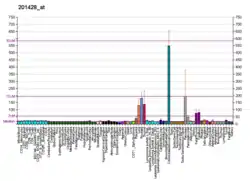CLDN4
Claudin 4, also known as CLDN4, is a protein which in humans is encoded by the CLDN4 gene. It belongs to the group of claudins.
| CLDN4 | |||||||||||||||||||||||||||||||||||||||||||||||||||
|---|---|---|---|---|---|---|---|---|---|---|---|---|---|---|---|---|---|---|---|---|---|---|---|---|---|---|---|---|---|---|---|---|---|---|---|---|---|---|---|---|---|---|---|---|---|---|---|---|---|---|---|
| Identifiers | |||||||||||||||||||||||||||||||||||||||||||||||||||
| Aliases | CLDN4, CPE-R, CPER, CPETR, CPETR1, WBSCR8, hCPE-R, claudin 4 | ||||||||||||||||||||||||||||||||||||||||||||||||||
| External IDs | OMIM: 602909 MGI: 1313314 HomoloGene: 1000 GeneCards: CLDN4 | ||||||||||||||||||||||||||||||||||||||||||||||||||
| |||||||||||||||||||||||||||||||||||||||||||||||||||
| |||||||||||||||||||||||||||||||||||||||||||||||||||
| |||||||||||||||||||||||||||||||||||||||||||||||||||
| |||||||||||||||||||||||||||||||||||||||||||||||||||
| |||||||||||||||||||||||||||||||||||||||||||||||||||
| Wikidata | |||||||||||||||||||||||||||||||||||||||||||||||||||
| |||||||||||||||||||||||||||||||||||||||||||||||||||
This gene encodes an integral membrane protein, which belongs to the claudin family. The protein is a component of tight junction strands and may play a role in internal organ development and function during pre- and postnatal life. This gene is deleted in Williams-Beuren syndrome, a neurodevelopmental disorder affecting multiple systems.[5]
Claudin 4 can also be used as a marker for distinguishing malignant mesothelioma from lung cancer and uterine serous carcinoma.[6] As a pancreatic cancer marker in cell-blocks of effusion specimens, it has also been found to have a superior performance to BerEp4 staining.[7]
References
- GRCh38: Ensembl release 89: ENSG00000189143 - Ensembl, May 2017
- GRCm38: Ensembl release 89: ENSMUSG00000047501 - Ensembl, May 2017
- "Human PubMed Reference:". National Center for Biotechnology Information, U.S. National Library of Medicine.
- "Mouse PubMed Reference:". National Center for Biotechnology Information, U.S. National Library of Medicine.
- "Entrez Gene: CLDN4 claudin 4".
- Ohta Y, Sasaki Y, Saito M, Kushima M, Takimoto M, Shiokawa A, Ota H (2013). "Claudin-4 as a marker for distinguishing malignant mesothelioma from lung carcinoma and serous adenocarcinoma". Int J Surg Pathol. 21 (5): 493–501. doi:10.1177/1066896913491320. PMID 23775021. S2CID 6840615.
- Vojtek M, Walsh MD, Papadimos DJ, Shield PW (2019). "Claudin-4 immunohistochemistry is a useful pan-carcinoma marker for serous effusion specimens" (PDF). Cytopathology. 30 (6): 614–619. doi:10.1111/cyt.12765. PMID 31390089. S2CID 199468828.
External links
- Human CLDN4 genome location and CLDN4 gene details page in the UCSC Genome Browser.
Further reading
- Kniesel U, Wolburg H (2000). "Tight junctions of the blood–brain barrier". Cell. Mol. Neurobiol. 20 (1): 57–76. doi:10.1023/A:1006995910836. PMID 10690502. S2CID 26473781.
- Heiskala M, Peterson PA, Yang Y (2001). "The roles of claudin superfamily proteins in paracellular transport". Traffic. 2 (2): 93–8. doi:10.1034/j.1600-0854.2001.020203.x. PMID 11247307. S2CID 12132159.
- Tsukita S, Furuse M, Itoh M (2001). "Multifunctional strands in tight junctions". Nat. Rev. Mol. Cell Biol. 2 (4): 285–93. doi:10.1038/35067088. PMID 11283726. S2CID 36524601.
- Tsukita S, Furuse M (2003). "Claudin-based barrier in simple and stratified cellular sheets". Curr. Opin. Cell Biol. 14 (5): 531–6. doi:10.1016/S0955-0674(02)00362-9. PMID 12231346.
- González-Mariscal L, Betanzos A, Nava P, Jaramillo BE (2003). "Tight junction proteins". Prog. Biophys. Mol. Biol. 81 (1): 1–44. doi:10.1016/S0079-6107(02)00037-8. PMID 12475568.
- Katahira J, Inoue N, Horiguchi Y, et al. (1997). "Molecular cloning and functional characterization of the receptor for Clostridium perfringens enterotoxin". J. Cell Biol. 136 (6): 1239–47. doi:10.1083/jcb.136.6.1239. PMC 2132509. PMID 9087440.
- Katahira J, Sugiyama H, Inoue N, et al. (1997). "Clostridium perfringens enterotoxin utilizes two structurally related membrane proteins as functional receptors in vivo". J. Biol. Chem. 272 (42): 26652–8. doi:10.1074/jbc.272.42.26652. PMID 9334247.
- Paperna T, Peoples R, Wang YK, et al. (1999). "Genes for the CPE receptor (CPETR1) and the human homolog of RVP1 (CPETR2) are localized within the Williams-Beuren syndrome deletion". Genomics. 54 (3): 453–9. doi:10.1006/geno.1998.5619. PMID 9878248.
- Morita K, Furuse M, Fujimoto K, Tsukita S (1999). "Claudin multigene family encoding four-transmembrane domain protein components of tight junction strands". Proc. Natl. Acad. Sci. U.S.A. 96 (2): 511–6. Bibcode:1999PNAS...96..511M. doi:10.1073/pnas.96.2.511. PMC 15167. PMID 9892664.
- Itoh M, Furuse M, Morita K, et al. (2000). "Direct binding of three tight junction-associated MAGUKs, ZO-1, ZO-2, and ZO-3, with the COOH termini of claudins". J. Cell Biol. 147 (6): 1351–63. doi:10.1083/jcb.147.6.1351. PMC 2168087. PMID 10601346.
- Strausberg RL, Feingold EA, Grouse LH, et al. (2003). "Generation and initial analysis of more than 15,000 full-length human and mouse cDNA sequences". Proc. Natl. Acad. Sci. U.S.A. 99 (26): 16899–903. Bibcode:2002PNAS...9916899M. doi:10.1073/pnas.242603899. PMC 139241. PMID 12477932.
- Colegio OR, Van Itallie C, Rahner C, Anderson JM (2003). "Claudin extracellular domains determine paracellular charge selectivity and resistance but not tight junction fibril architecture". Am. J. Physiol., Cell Physiol. 284 (6): C1346–54. doi:10.1152/ajpcell.00547.2002. PMID 12700140.
- Katoh M, Katoh M (2004). "CLDN23 gene, frequently down-regulated in intestinal-type gastric cancer, is a novel member of CLAUDIN gene family". Int. J. Mol. Med. 11 (6): 683–9. doi:10.3892/ijmm.11.6.683. PMID 12736707.
- Hillier LW, Fulton RS, Fulton LA, et al. (2003). "The DNA sequence of human chromosome 7". Nature. 424 (6945): 157–64. Bibcode:2003Natur.424..157H. doi:10.1038/nature01782. PMID 12853948.
- Michl P, Barth C, Buchholz M, et al. (2003). "Claudin-4 expression decreases invasiveness and metastatic potential of pancreatic cancer". Cancer Res. 63 (19): 6265–71. PMID 14559813.
- Liu F, Koval M, Ranganathan S, Fanayan S, Hancock WS, Lundberg EK, Beavis RC, Lane L, Duek P, McQuade L, Kelleher NL, Baker MS (2015). "A systems proteomics view of the endogenous human claudin protein family". J Proteome Res. 15 (2): 339–59. doi:10.1021/acs.jproteome.5b00769. PMC 4777318. PMID 26680015.
- Ohta Y, Sasaki Y, Saito M, Kushima M, Takimoto M, Shiokawa A, Ota H (2013). "Claudin-4 as a marker for distinguishing malignant mesothelioma from lung carcinoma and serous adenocarcinoma". Int J Surg Pathol. 21 (5): 493–501. doi:10.1177/1066896913491320. PMID 23775021. S2CID 6840615.
- Vojtek M, Walsh MD, Papadimos DJ, Shield PW (2019). "Claudin-4 immunohistochemistry is a useful pan-carcinoma marker for serous effusion specimens" (PDF). Cytopathology. 30 (6): 614–619. doi:10.1111/cyt.12765. PMID 31390089. S2CID 199468828.
This article is issued from Wikipedia. The text is licensed under Creative Commons - Attribution - Sharealike. Additional terms may apply for the media files.




